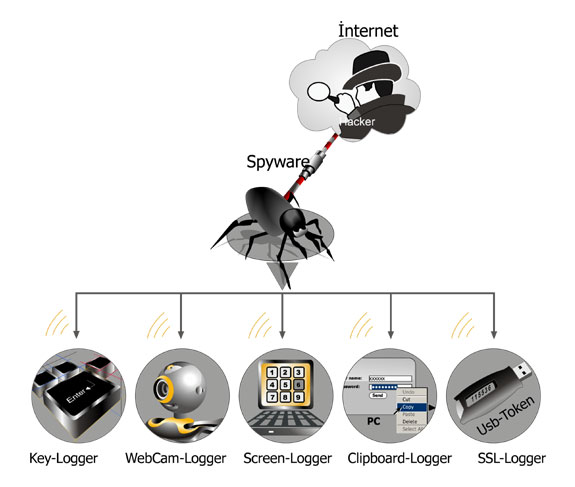What is the internet security?
Internet security is a part of overall computer security. With being specifically related
to the Internet, it's main aim is browser and network protection for users.
The Internet is itself hazardous place. We do our shopping online, do banking, download and share files on it.
Thieves, especially con artists, exploit user's inexperience to trick, access and to steal our data,
which can be used to faciliate tasks, without user to know. Therefore, we have threats on the Internet, but we have means to protect ourselves!
Well, we will discuss Internet security, in terms of threat and protection. The threat, we will process, is keylogging and spyware. The protection that will be discussed are firewalls. So, let's get started, shall we?
Spyware and keylogging
There are many ways that scammers and thieves can attack and steal our personal data (name, DOB, SIN number etc.) and financial (chequebook data, credit card info, PINs etc.). However, spyware and keylogging are one of the prefered ways to exploit and steal data. But How? The next passages should and will explain.

Diagram of how does spyware works.
Spyware is a malware installed secretly on user's computer by thiefs, to collect and send personal data to the thief. Generally, to get a spyware installed, the con artist must make it in a manner, that no anti-virus can detect the spyware. Also, the main method is to exploit a vulnerability in software, that still isn't patched up. Or, the target computer doesn't have the patch installed.
A simple scenario of how spyware can be used
Suppose that a con artist wants to get your credit card information, in order to make unauthorized purchases in your name. He/She will try to redirect to their versions of the website you visit, in order for you to download an innocent-looking program or file that contains a spyware. When opened, it is being installed, and it starts to send data to the creator, thief. When he gets the data he wanted, he can use it for his/her own needs. In the end, you are the victim.
Keylogging. Better and more dangerous internet threat than spyware?
 Example of keylogger program.
Keylogging is an another way how con artist can steal our data. Unlike spyware who are only software,
keyloggers can be both hardware and software. We'll talk about software keyloggers.
Example of keylogger program.
Keylogging is an another way how con artist can steal our data. Unlike spyware who are only software,
keyloggers can be both hardware and software. We'll talk about software keyloggers.
Keyloggers cannot be usually detected, which gives thieves easiness, when designing them.
The method they work is based on capturing keystrokes that user made, allowing schemers to track any data exchange.
How do they work?
As explained above, the attacker has to make victim get the keylogger. Some OSes, such as Kali Linux, offer feature to create keyloggers, and place them into a Word document, assuming that victim doesn't have a patch that neutralizes this vulnerability. Then, hacker writes a content of a document, and e-mails to the victim. With one click, keylogger install itself on the host, and starts its payload (i.e. sends any recorded keystroke back to its creator.) After that, con artist stole victim's data!
Protection from Internet threats (Firewalls)
With many threats on the Internet, how can you protect yourself?
One way you can protect yourself is to install a firewall.
 Many companies have firewalls to prevent unauthorized access into its internal network.
Also, it prevents IP adress spoofing, tactic used by hackers to penetrate the network.
Many companies have firewalls to prevent unauthorized access into its internal network.
Also, it prevents IP adress spoofing, tactic used by hackers to penetrate the network.
Demonstration of does firewall work
Someone tries to hack into the network. When he attempts to do so, he cannot. Why?
Firewall prevented that scenario from happening! The hacker tried to impersonate someine else that network trusts.
However, firewall notices the discrepencies, and prevented hacker from gaining access to the network. This is how
firewall works.
In conclusion, every Internet threat teaches us how to protect ourselves and how to prevent any damages caused by them.